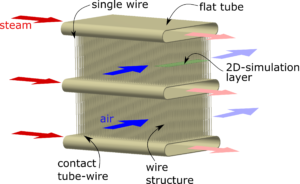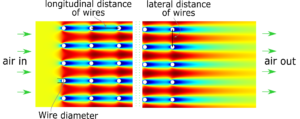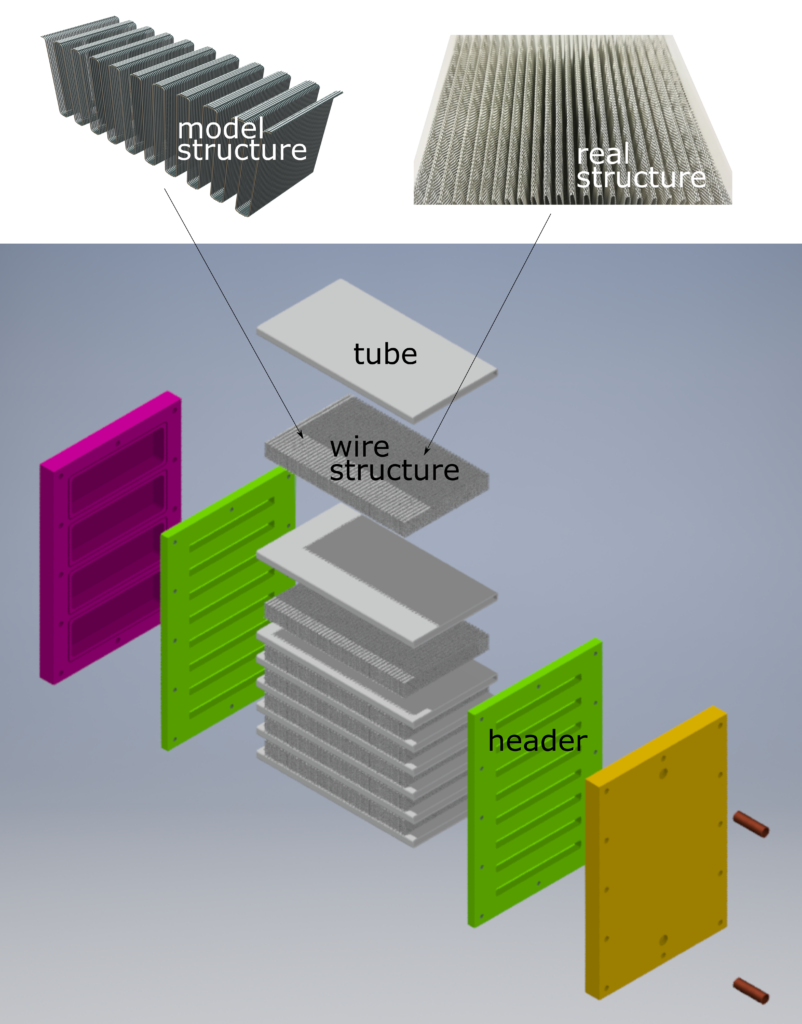Air-cooled condensers for dry heat rejection are generally enlarged on the air side by different kind of fins, such as louvered fins, wavy fins or offset strip fins. These fins are manufactured by metal sheets and connected to the tube walls by a metal-joining process. However, the possible surface area enlargement is in the range of the surface area of the underlying metal sheets. In order to increase the surface area further on, without using more material, wire structures can be used as fins instead of metal sheets. In addition, fluid flow along wire structures experiences a very high heat transfer coefficient due to the repeating interruptions and small dimensions.
New textile developments enable the fabrication of adapted structures with non-regular grid sizes purpose-built for air-cooled condensers. Fraunhofer ISE and Kelvion Thermal Solutions designed a first concept of an innovative heat transfer surface area enhancement on the air side for an air-cooled condenser. The concept is based on geometrical and thermodynamic boundary conditions of an air-cooled condenser of a CSP plant in Morocco which is based on dry-cooling technology. The concept encompasses the heat transfer enhancement with a corrugated textile fabric and an adapted flat tube selection. The wire structure is oriented towards the flat tubes in order to allow good conductivity with low material consumption (see Figure 1). Performance estimation is based on CFD-Simulation of air flow through the wire structure. Therefore, finite element method is used based on the software Comsol Multiphysics. A comparison of simulated performance with the reference air-cooled condenser shows a strong decrease in material consumption for the surface enhancement in the order of 40%-50%. However, the total mass of the heat exchanger (aluminum fins/wires and steel tubes) could be reduced by only 10% in the simulation. In the design ideas pressure drop and heat transfer rate would be in the range of the reference condenser with a slightly increased thermal effectiveness of 5% for the wire structure at equal pressure drop.

Figure 1: Wire structure embedded between flat tubes blue (figure: Hannes Fugmann, Fraunhofer ISE; [1])

Figure 2: Cross section through a wire structure heat exchanger. Higher Velocities in red, lower velocities in blue (figure: Hannes Fugmann, Fraunhofer ISE; [2])

Figure 3: Design of a wire structure heat exchanger for a measuring campaign at Fraunhofer ISE blue (figure: Hannes Fugmann, Fraunhofer ISE)
At this stage, wire structure heat exchanger simulation show benefits in terms of material consumption and heat transfer characteristics, however, some manufacturing, handling, and stability questions are still open and have to be considered within MinWaterCSP in the following months.
Author: Hannes Fugmann, Fraunhofer ISE, Germany
About Fraunhofer ISE
Fraunhofer is Europe’s largest solar energy research institution. In the solar thermal field, Fraunhofer ISE is pursuing R&D on materials research and component development for both improved flat-plate and concentrating collectors since about 15 years, but also on process integration and systems.
Follow MinWaterCSP
Newsletter subscription: http://www.minwatercsp.com/newsletter-subscription/
Twitter: https://twitter.com/MinWaterCSP
LinkedIn profile: LinkedIn
References
[1] Fugmann, H.; Schnabel, L.; Frohnapfel, B. Simulation of Thermal and Fluid Dynamic Characteristics of Wire Structure Heat Exchangers. , to be published 2018.
[2] Fugmann, H.; Di Lauro, P.; Schnabel, L. Heat Transfer Surface Area Enlargement by Usage of Metal Textile Structures – Development, Potential and Evaluation. In International Textile Conference; TU Dresden, Ed., 2016.





